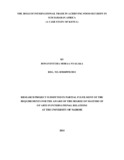| dc.description.abstract | A vibrant agricultural sector is very critical for alleviating SSA's current food security crisis, and
for laying the foundations of sustained future economic growth. In recent years, nonetheless,
agriculture has performed poorly in many African countries including Kenya. Efforts for its
recovery, often through structural adjustment lending, have suffered from inadequate information
about country and regional specific factors, and from an emphasis on macroeconomic policies
without complementary interventions at the sector level as well as limited or no international
trade interactions.
This research project describes the patterns of agricultural growth in Kenya in relation to other
SSA states like Rwanda, Angola and evaluates price and non-price aspects of three sets of
factors: initial endowments and subsequent exogenous developments, general economic
influences, and sectoral issues and policies. It suggests that government action at the sectoral and
subsector levels in such critical areas as land policy, smallholders' access to inputs, and
agricultural research needs to be combined with trade and macroeconomic reforms to achieve
sustained and broad based agricultural growth.
On the other hand, countries at early stages of development in Africa rely tremendously on
agricultural growth for food, employment, foreign exchange reserves and lowering government
budget deficit. The analysis indicates that agricultural prices and production have generally
declined. The performance of the agricultural sector in the 1990s was depressing, with annual
growth in agricultural GDP averaging 2% compared with 4% in the 1980s. Agricultural export
growth after the reforms has shown varied trends due to market access restrictions for Kenyan
exports. Market access for imports into the Kenyan market has been enhanced since the reforms,
occasioning tremendous import growth.
However, the capacity to import food has plummeted, occasioning the country into more food
insecure issues. The balance of trade between Kenya and the rest of the world has deteriorated
against Kenya. The study supports that after the reforms the country moved from broad self-sufficiency
in production of most food staples to a net importer. However, execution of
liberalized policies is supposed to be harmonized and coordinated to circumvent adverse effects
on the sector to shield Kenya against food insecurity cases.
Finally, progress toward a food secure nation can be achieved by implementing effective
government policies that support small-scale farmers with key tools and seeds, while intensifying
irrigation and supporting environmentally sustainable production methods to tackle the endemic
problems of land e.g. fertility or soil erosion in the country. | en_US |

